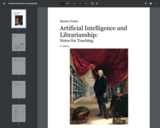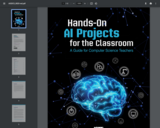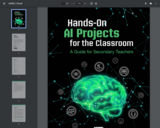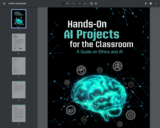
This image describes the basic character of Artificial Intelligence
- Subject:
- Educational Technology
- Material Type:
- Lesson
- Teaching/Learning Strategy
- Author:
- Thiyagu K
- Date Added:
- 08/25/2024

This image describes the basic character of Artificial Intelligence

The arrival of artificial intelligence has sent shockwaves through numerous industires. Instructional design and education, like many other fields, are bracing for impact. The conversation around AI in instructional design and education has ranged from doomsday scenarios to claims of a new savior. The only constraint in these projects is a general lack of data supporting either scenario. To inform our strategy plan for the utilization and adoption of AI tools, the AI working group at Emeritus Institute of Management conducted a pilot study, assaying the impacts of two tools, ChatGPT and Blue Willow, on the efficiency and effectiveness of these tools in completing common design tasks. This paper describes our study design and the results of our experiment.

An AI Teacher Assistant refers to an artificial intelligence-driven tool or system designed to support teachers in their daily tasks, improve instructional practices, and enhance student learning outcomes. These tools are not meant to replace teachers but to assist them in various ways by automating repetitive tasks, providing insights, and enabling personalized learning experiences

This presentation consist of Artificial intelligence tools for commerce teaching and research

This course introduces students to the basic knowledge representation, problem solving, and learning methods of artificial intelligence. Upon completion of 6.034, students should be able to develop intelligent systems by assembling solutions to concrete computational problems; understand the role of knowledge representation, problem solving, and learning in intelligent-system engineering; and appreciate the role of problem solving, vision, and language in understanding human intelligence from a computational perspective.

Courses on Artificial Intelligence (AI) and Librarianship in ALA-accredited Masters of Library and Information (MLIS) degrees are rare. We have all been surprised by ChatGPT and similar Large Language Models. Generative AI is an important new area for librarianship. It is also developing so rapidly that no one can really keep up. Those trying to produce AI courses for the MLIS degree need all the help they can get. This book is a gesture of support. It consists of about 100,000 words on the topic, with a 4-500 item bibliography. It is the 2024 Third Edition of a 2024 Second Edition. Changes to the third edition include:
• a new Chapter 6 on evaluation and the future
• new materials in Chapter 5 on current large language and multimodal models
• scattered revisions, corrections, and updates.

This is a class about applying autonomy to real-world systems. The overarching theme uniting the many different topics in this course will center around programming a cognitive robotic. This class takes the approach of introducing new reasoning techniques and ideas incrementally. We start with the current paradigm of programming you’re likely familiar with, and evolve it over the semester—continually adding in new features and reasoning capabilities—ending with a robust, intelligent system. These techniques and topics will include algorithms for allowing a robot to: Monitor itself for potential problems (both observable and hidden), scheduling tasks in time, coming up with novel plans to achieve desired goals over time, dealing with the continuous world, collaborating with other (autonomous) agents, dealing with risk, and more.

This resource is to support teachers and educators to run Day of AI activities in their classrooms through curriculum packages and teacher training, all of which is available at no cost to participants.
Developed by leading faculty and educators from MIT RAISE, the curriculum features up to four hours of hands-on activities that engage kids in creative discovery, discussion, and play as they learn the fundamentals of AI, investigate the societal impact of these technologies, and bring artificial intelligence to life through lessons and activities that are accessible to all, even those with no computer science or technical background.

This course explores the reciprocal relationships among design, science, and technology by covering a wide range of topics including industrial design, architecture, visualization and perception, design computation, material ecology, and environmental design and sustainability. Students will examine how transformations in science and technology have influenced design thinking and vice versa, as well as develop methodologies for design research and collaborate on design solutions to interdisciplinary problems.

Artificial Intelligence (AI), and the algorithmic judgment at its core, is developing at breakneck speed. This version of the popular Ethics for Engineers course focuses on the ethics issues involved in the latest developments of computer science.

This video aims to delve into the human problems brought out by issues in artificial intelligence, specifically with respect to bias. It is suitable for classroom use or as a standalone video for those who wish to understand the issue more deeply than is conventionally covered. For classroom use, we recommend watching the chapterized version of the video and working through the teaching materials provided for each chapter.

In an effort to build the capacity of the students and faculty on the topics of bias and fairness in machine learning (ML) and appropriate use of ML, the MIT CITE team developed capacity-building activities and material. This material covers content through four modules that an be integrated into existing courses over a one to two week period.

This course about financial technology, or FinTech, is for students wishing to explore the ways in which new technologies are disrupting the financial services industry—driving material change in business models, products, applications and customer user interface. Amongst the significant technological trends affecting financial services into the 2020’s, the class will explore AI, deep learning, blockchain technology and open APIs. Students will gain an understanding of the key technologies, market structure, participants, regulation and the dynamics of change being brought about by FinTech.

The emergence of transformer architectures in 2017 triggered a breakthrough in machine learning that today lets anyone create computer-generated essays, stories, pictures, music, videos, and programs from high-level prompts in natural language, all without the need to code. That has stimulated fervent discussion among educators about the implications of generative AI systems for curricula and teaching methods across a broad range of subjects. It has also raised questions of how to understand both these systems and the at times overstated claims made for them. This class will introduce the foundations of generative AI technology, and participants will explore new opportunities it enables for K–12 education. It will also describe and explore how an analytical frame of mind can help make clear the core issues underlying both the successes and failures of these systems. Much of the work will be project-based, involving implementing innovative teaching and learning tools and testing these with K–12 students and teachers.

How are math, art, music, and language intertwined? How does intelligent behavior arise from its component parts? Can computers think? Can brains compute? Douglas Hofstadter probes very cleverly at these questions and more in his Pulitzer Prize winning book, “Gödel, Escher, Bach”. In this seminar, we will read and discuss the book in depth, taking the time to solve its puzzles, appreciate the Bach pieces that inspired its dialogues, and discover its hidden tricks along the way.

The projects in this guide use a student-driven approach to learning. Instead of simply learning about AI through videos or lectures, the students completing these projects are active participants in their AI exploration. In the process, students work directly with innovative AI technologies, participate in “unplugged” activities that further their understanding of how AI technologies work, and create various authentic products—from machine learning models to video games—to demonstrate their learning.
Project 1: Programming with Machine Learning
Project 2: AI-Powered Players in Video Games
Project 3: Using AI for Robotic Motion Planning
Project 4: Machine Learning as a Service
Visit the ISTE website with all the free practical guides for engaging students in AI creation: https://www.iste.org/areas-of-focus/AI-in-education

This guide provides student-driven projects that can directly teach subject area standards in tandem with foundational understandings of what AI is, how it works, and how it impacts society. Several key approaches were taken into consideration in the design of these projects. Understanding these approaches will support both your understanding and implementation of the projects in this guide, as well as your own work to design further activities that integrate AI education into your curriculum.
Project 1: AI Chatbots
Project 2: Developing a Critical Eye
Project 3: Using AI to Solve Environmental Problems
Project 4: Laws for AI
Visit the ISTE website with all the free practical guides for engaging students in AI creation: https://www.iste.org/areas-of-focus/AI-in-education

In this guide, students’ exploration of AI is framed within the context of ethical considerations and aligned with standards and concepts, and depths of understanding that would be appropriate across various subject areas and grade levels in K–12. Depending on the level of your students and the amount of time you have available, you might complete an entire project, pick and choose from the listed activities, or you might take students’ learning further by taking advantage of the additional extensions and resources provided for you. For students with no previous experience with AI education, exposure to the guided learning activities alone will create an understanding of their world that they likely did not previously have. And for those with some background in computer science or AI, the complete projects and resources will still challenge their thinking and expose them to new AI technologies and applications across various fields of study.
Project 1: Fair's Fair
Project 2: Who is in Control?
Project 3: The Trade-offs of AI Technology
Project 4: AI and the 21st Century Worker
Visit the ISTE website with all the free practical guides for engaging students in AI creation: https://www.iste.org/areas-of-focus/AI-in-education.

To improve the students’ understanding of AI, Aspen Digital developed a lesson plan to teach students how to recognize and critically interpret how writing choices impact readers’ perceptions of how AI works, what it can be used to do, and who is using it.

This is MIT’s introductory course on deep learning methods with applications to computer vision, natural language processing, biology, and more! Students will gain foundational knowledge of deep learning algorithms and get practical experience in building neural networks in TensorFlow. Course concludes with a project proposal competition with feedback from staff and panel of industry sponsors. Prerequisites assume calculus (i.e. taking derivatives) and linear algebra (i.e. matrix multiplication), and we’ll try to explain everything else along the way! Experience in Python is helpful but not necessary.